Introduction
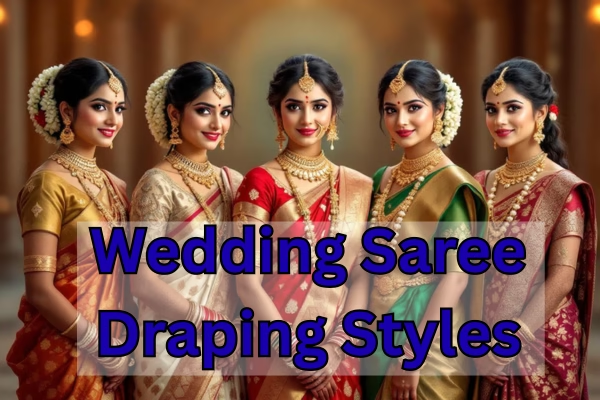
Sarees are an icon that depicts eternal beauty and culture in India. Their versatile wedding saree draping styles provide women with the opportunity to be unique and celebrate tradition. Whether it is a wedding or a casual outfit, the way the saree is worn changes the appearance, and hence, it can be worn in any mood or occasion.
The overall appearance mostly depends on the draping style of a saree. It modifies the posture, the outlines, and the elegance. Every woman wants to have a custom saree, and she can enhance the look with little effort through the art of draping. A traditional, modern, or fusion outlook is achievable through the drape that makes the dress appealing and matches the individual’s style and the nature of the occasion.
This blog is meant to feature 6 ways of saree draping style for a wedding, a party, and a day-to-day event. Exploring the world of traditional and modern styles, readers will get to know new options for styling their sarees for any occasion to practice their cultural roots with references to contemporary fashion and comfort.
Nivi Style (Andhra Pradesh Classic)
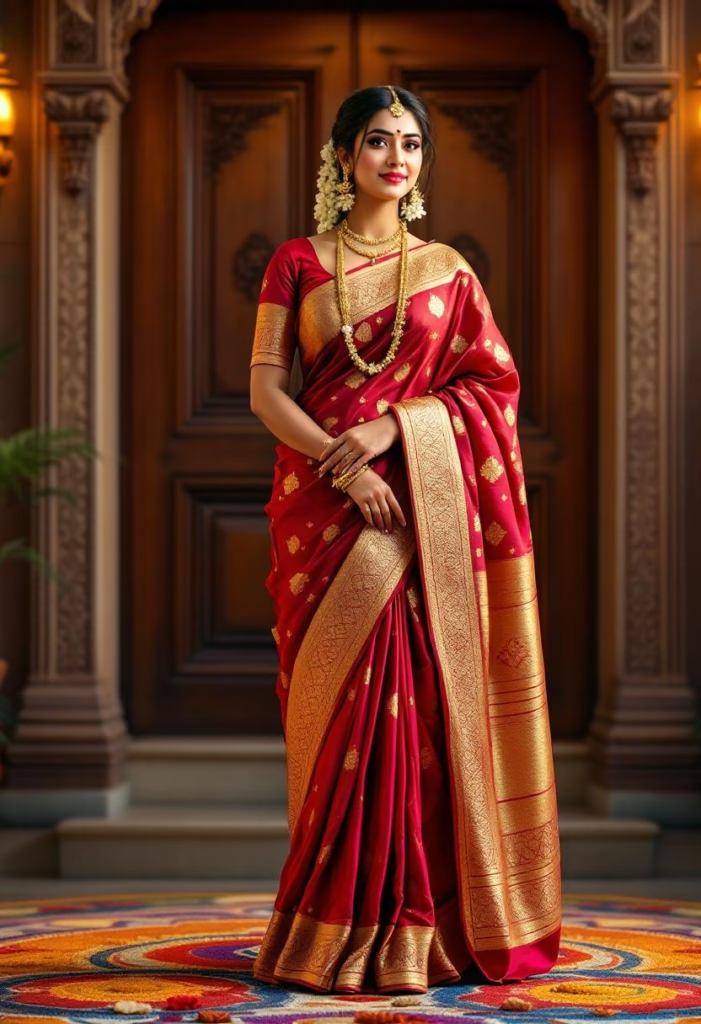
A well-known and common design of saree drape is Nivi, which is the traditional mode of wearing saree and originated in Andhra Pradesh. The Nivi drape is simple, graceful, and elegant because of which is has become the norm all over India and very frequently becomes the choice of traditional and modern brides.
Origin of Nivi Style
The Nivi wedding saree draping styles can be traced to ancient South India, especially Andhra, where the style was worn by the noblewomen and the temple dancers. In the course of time, its enhanced, flattering shape established itself as a standard across India. The fact that it is easy to move as well as flattering to any shape of the body is what made it become the most popular saree draping style in the country.
How to Wear the Nivi Style Saree
Here’s a step-by-step guide for wedding saree draping styles in the classic Nivi style:
- Petticoat & Blouse: A well-fitted blouse will go with the matching petticoat and tie the saree around the waist.
- Tuck in the Saree: Take the right side of the saree and tuck it inside the petticoat and cover it once around the waist.
- Pleat: Establish even pleats (5 to 7.5-inch length) inside the forward, and curl them into the mid position of your waist.
- Pallu: The loose end (pallu) can be brought over the left shoulder and allowed to fall gracefully at the back. One can fix it up against supporting or allow it to dangle.
- Optional styling: In case of brides, the pallu should be pleated and pinned or overlaid with a decorative belt (kamarbandh).
Where and When to Wear the Nivi Style
- Weddings (as a bride or guest): Particularly in the South Indian wedding saree draping style, women paired with a silk saree such as Kanjivaram or Pattu.
- Engagements and Receptions: Eternal and grand, perfect accessories using deep fabrics and heavy jewellery.
- Holidays: It is a very versatile design that looks fantastic during the holidays, during Diwali, or when organising a family get-together.
- Temple Ceremonies: It is highly traditional, and it regards religious and cultural concerns.
Why Choose Nivi for Wedding Saree Draping Styles
- Timeless, universally suitable, also pleasing to the style for large – Classic elegance.
- Versatile: Goes with any body type and can be worn with any fabrics such as silk, georgette, or chiffon.
- The culturally authentic ones, especially meant for South Indian Weddings, look extremely traditional yet elegant.
Styling Tips for Nivi Style
- Choose to wear an expensive Banarasi jas, Patola, or Kanjivaram saree on a marriage occasion.
- To achieve a traditional bridal image, accessorise with traditional jewellery like temple jewellery, jhumka, and gajra (flowers).
- Wrap a belt around the pallu or pin it to hold the pallu neatly and fashionably.
When you include the Nivi saree draping style in your list of wedding saree draping styles, it is ensured that you combine tradition, elegance and comfort. This style will place you in the wedding-ready position whether you are a bride or it is merely yourself attending the wedding as a guest, wherein your style looks natural and thus, very elegant.
Bengali Style (Traditional Red & White Vibe)
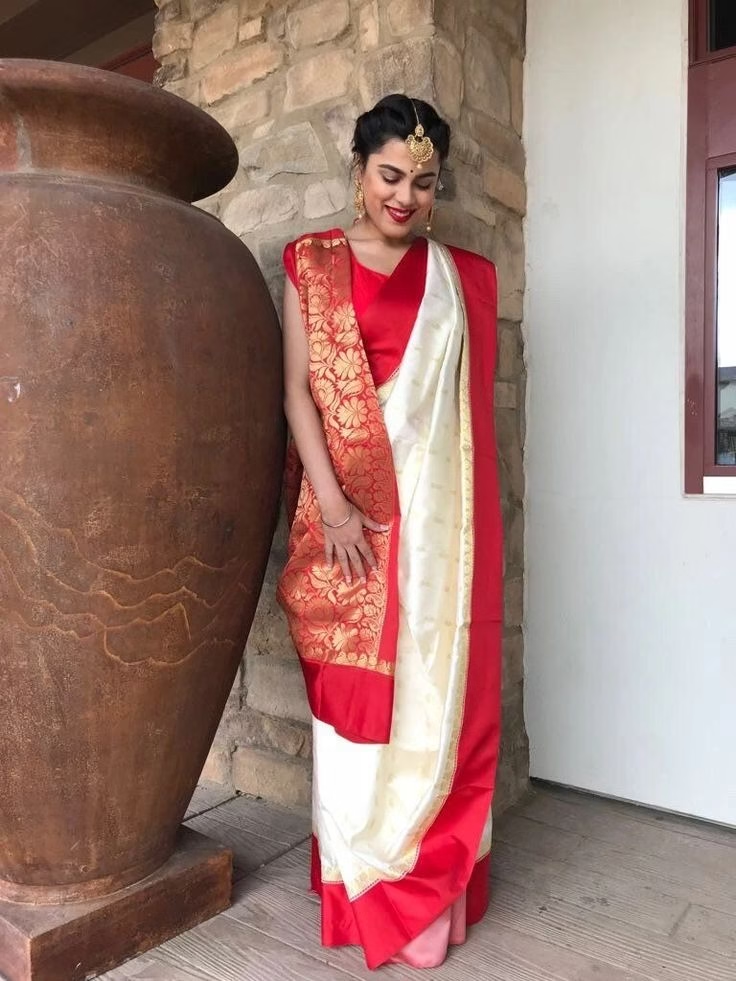
Bengali wedding saree draping styles are more elegant and higher than wedding saree draping styles, and they look more cultural. Famous for its wide, elegant pallu and the symbolic colour duo red-and-white, this design is traditional to Bengali brides; later it became Global Goal Bengali for every woman or Bengali brides for being its historic charm.
Origin of the Bengali Saree Draping Style
The saree drape is a conventional dress style of West Bengal. It has been a tradition that has been practiced for generations. The Bengali saree draping styles, in particular, are worn especially on the occasions of weddings and festivals such as Durga Puja, which is a symbol of elegance, strength, and a rich culture. A white saree with red border draws out the meaning of purity, horn of plenty, and a good start- great items to start your marriage with.
How to Wear the Bengali Saree Draping Style
- Put on the Right Foundation: Put on a blouse and tie up the saree around your waist, starting with the right hand.
- Wrap Around the Waist: Wrap the saree all the way around the waist and make it in place.
- Front Pleats: This is the biggest pleat on the front, neatly tucked in the center.
- Tie Pallu: Pull the left side of the pallu out of the right arm, over to the left shoulder, but do not pleat the cloth; make it fall wide and grandiose.
- Additional Second Drape: As a traditional version, the pallu is taken back to the right shoulder and could have keys or a piece of decoration on it, reflecting on the occupation of a married woman.
When to Wear This Bengali Wedding Saree Draping Styles
- Bengali Weddings Traditional – Suitable for the bridal ceremonies such as sindoordaan and shubho drishti.
- Cultural Mating Ceremonies- Gives some authenticity and style to themed or regional weddings.
- Festive Bridal Occasions – Excellent when you have to wear it during Durga Puja, Mehendi, or an engagement ceremony and have to flaunt a cultural dress style.
Why Choose Bengali Drape for Wedding Saree Draping Styles
- Rich Tradition: It signifies great cultural importance and belonging.
- Photogenic Appeal: With the dramatic bind and vibrant red- white contrast, it makes for a striking and beautiful look.
- An Exclusive Silhouette – Contrary to other wedding saree draping fashion, wear a Bengali drape freely and does not make a high score stressing on skeptical pleating or pinning.
Styling Tips for Bengali Bridal Look
- Go for tangail, tussar, or Baluchari sarees with red borders for the authentic look.
- Match with traditional gold jewellery, which includes choker, nose ring, and shankha pola bangles.
- Complete the look with alta (red dye) on your hands and feet. and bold red bindi.
Gujarati Seedha Pallu (Grace with a Twist)
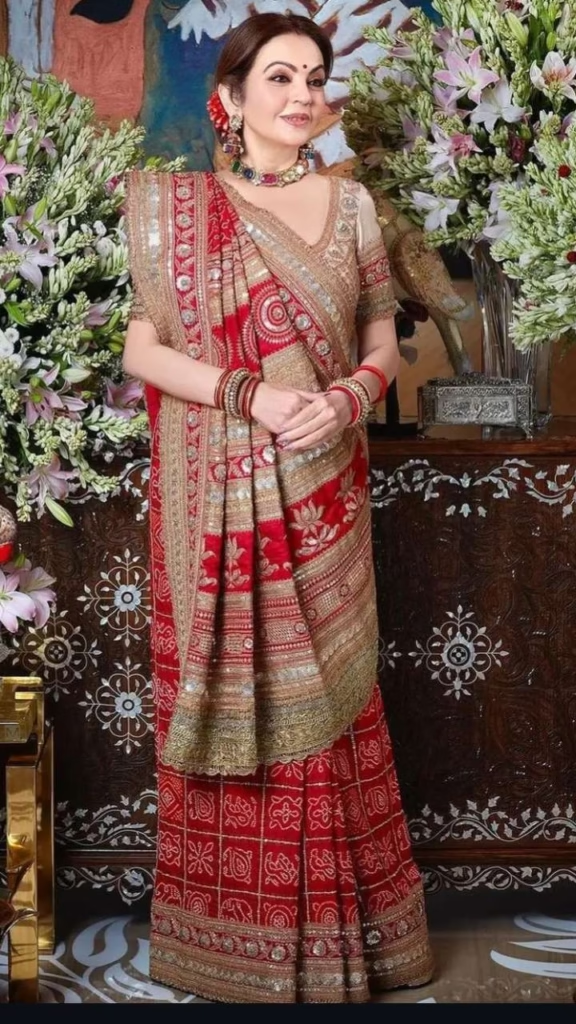
The Gujarati Seedha Pallu is a striking & unique saree draping style featuring her front-faced pallu motifs beautifully cascading over the shoulder. This style feminizes with regal charm and cultural decency to any aoral type wedding look on making it a classic imported style among the traditional wedding saree draping style, especially in Gujarat and the North India.
Origin of the Gujarati Saree Draping Style
The Seedha Pallu saree drape has a long history, taking its origin in vibrant Gujarati culture, and women have worn it during weddings, festivals, and other religious occasions. It represents elegance and pride, and it also enables the wearer to reveal the intricate border and pallu embroidery shown on the saree on the front side, which is an aesthetic bonus when it comes to bridal wear.
How to Wear the Gujarati Seedha Pallu wedding saree draping Style
This wedding saree draping style here is that of perfectly revealing the reverse pallu in front of the shoulder instead of at the back. How to style it is as follows:
- Start off at the Waist – Take the plain end of the saree and face the petticoat inside and the right side, and then literally once round the waist, left to right.
- Form Front Pleats: Form 5- 7 pleats and tuck at the centre in the front, just like Nivi style.
- Wear the Pallu in a different style: Here, get the rest of the saree, which was lying like the handle of the saree, and bring it around the back to the right shoulder and spread the pallu across the chest.
- Pin or Pleat the Pallu: Have the pallu hang attractively in front, either pleated or not pleated. Other brides decorate it to fasten it with a fancy brooch or belt.
- Put a twist to it: Fold the pallu back once at the back to have a secured and completed wedding saree draping style, especially in active ceremonies as Garba or pheras.
When to Wear This Wedding Saree Draping Styles
- Gujarati Weddings- the main ceremony- the most usually used by the brides and the women of the bridal party.
- Pre-Wedding Events: It can be something like Garba, Sangeet, or Haldi. Comfort and elegance are important attributes here.
- Cultural or Themed Weddings – During the demonstration of local traditions or heritage through clothing.
Styling Tips for Gujarati Bridal Look
- To be traditional, prefer Panetar saree (white decorated with red), Bandhani, or Patola silk.
- Ornament with kundan jewellery, matha patti, nath, and bangles piled along the arms.
- And fasten the pallu with a belt around the waist (kamarbandh) and give a bridal look.
- Choose a conventional hairstyle such as a bun of gajra (flowers) or a braided up-do.
Gujarati Seedha Pallu is by far the ideal combination of elegant and daring tradition in all the wedding saree draping styles. Not only does it promote the region and the notion of regional identity, but it also provides a special twist to the bridal dressing style as the bride can be able to portray some elegant, cultural, and individualistic sense in just one magnificent drape.
Maharashtrian Nauvari (Royal and Regal)
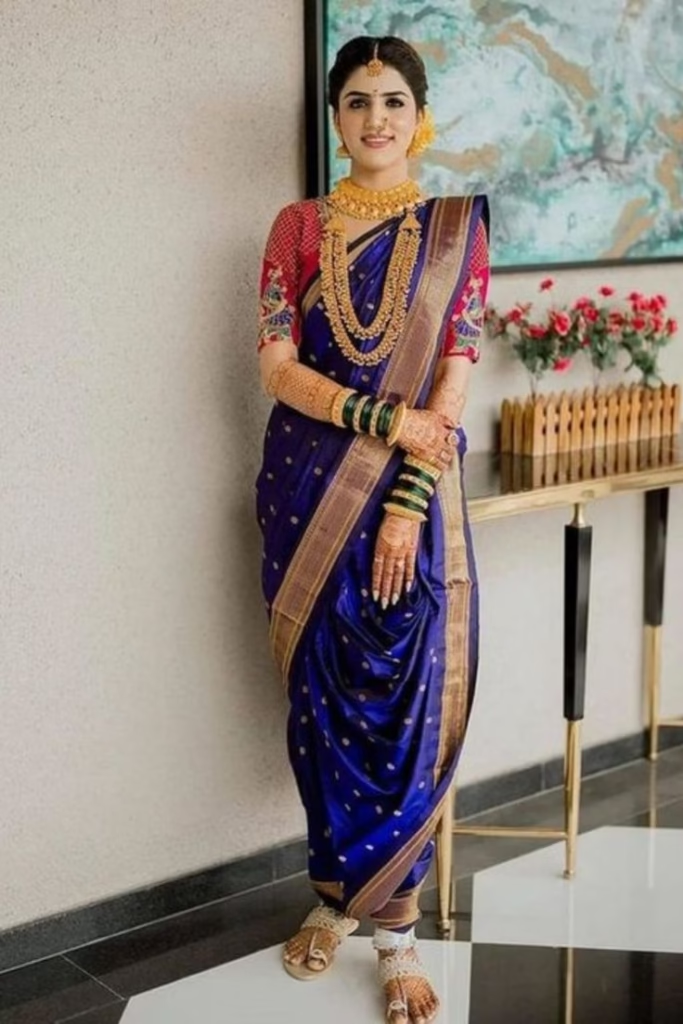
Among India’s most renowned traditional wedding saree draping styles, Maharashtrian Nauvari finds a place for itself due to its bold blend of femininity and fight spirit. Similar to Dhoti, this nine-yard style (for that reason Nauvari) shows the strength, tradition, and supreme luxury— making it an eternal aspiration for brides looking conceivably solely comfort and traditional elegance.
Origin of the Nauvari Saree Draping Style
Nauvari drape is of the Maharashtra region, where women used to wear this form as they found it convenient to move around in the chores, wars, and rituals. The saree is worn without a petticoat and is brought down between the legs and is wrapped in a fashion that closely represents the dhoti, symbolic of power and self-reliance, which is a prerequisite in Maharashtrian bridal culture.
How to Wear the Maharashtrian Nauvari Style
This dynamic and bold wedding saree draping style requires a 9-yard saree (longer than the usual 6 yards). Here’s how it’s worn:
- Begin with the Center: Insert the central part of the saree inside the back of your waist, leaving both sides with the same length.
- Dhoti Style: Grab each end and bring it to the front between your legs and slip into the waistband, creating a figure of dhoti-style bottom.
- To Drape Around the Legs: Take the end and wrap around the left leg, and the other around the right leg, and tie at the waist.
- Pallu: Put the extra cloth and fold the left (or right) shoulder over the pallu and pleat it or fold loosely, depending on the feel.
- Pin Up: To ensure everything was stable when wearing a traditional wedding outfit, one used pins and a waist chain (kamarpatta).
When to Wear This Wedding Saree Draping Style
- Maharashtrian Weddings- Brides used to wear the saree when they are undergoing Muhurta, Antarpat, etc.
- Pre-Wedding Functions: During Haldi, Mangalashtak ceremonies, or during other ceremonies like Lavni are especially lively.
- Cultural Events or Temple Ceremonies – Here traditional wear of the region is followed and welcomed.
Why Choose Nauvari for Wedding Saree Draping Styles
- Strength & Heritage: An ode to warrior queens and women living in the countryside of Maharashtra.
- Comfort and Mobility: These wedding saree draping styles are comfortable and easy to move in.
- Distinctive profile: The Nauvari is also in contrast with the majority of saree draping styles; it accentuates the legs and the waistline, which creates a proud and stately bridal posture.
Styling Tips for the Maharashtrian Bridal Look
- Go for traditional Paithani sarees or rich Buva or cotton-silk Nauvaris in colours like saffron, green, and maroon.
- Dress up with a Maharashtrian signature jewelry—the nath, mundavalya (headstring), chooda (green glass bangles), and gold necklaces.
- To complete the look, go for a tight bun or braid with a gajra added.
- A Monochromatic salwaar suit can be teamed up with Kolhapuri chappals or traditional mojris to make the look even more authentic.
The epic Maharashtrian Nauvari is one of the many wedding saree draping styles that present a statement because it has a history behind it. It allows brides to have the duality of being gracious and powerful, which is ideal for the contemporary woman who holds old-fashioned beliefs. The Nauvari is memorable whether you are a Maharashtrian bride or like a bridal appearance that is not run-of-the-mill.
Tamil Madisar (Brahmin Bridal Tradition)
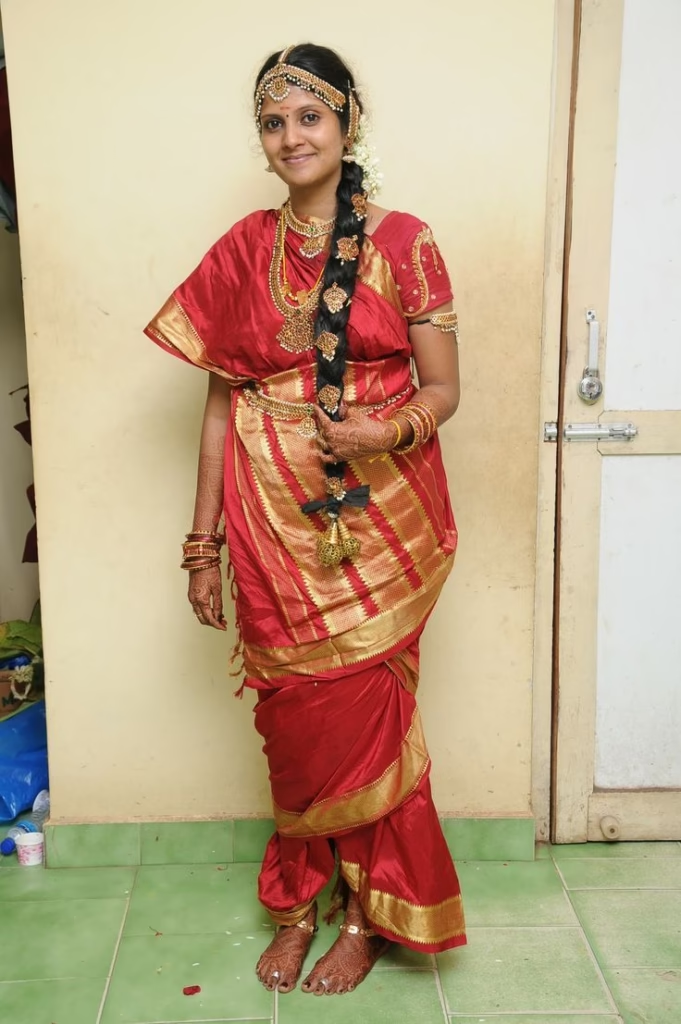
The Tamil Madisar is an ancient and traditional way of wedding saree draping styles popularly worn by Tamil Brahmin brides during weddings and religious functions. The Madisar is a unique 9-yard drape, which combines the best of both dhoti and saree and stands against spiritual purity, marital status, and the rich culture of South India.
Origin of the Tamil Madisar Saree Draping Style
Among all the wedding saree draping styles, the Madisar style goes back to ancient Tamil Nadu, coming from Iyer and Iyengar Brahmin communities. It was traditionally a mark indicating a married woman’s passage into the grihastha life stage, an aspect that indicates that her life is going to be domestic. Traditionally the Madisar is worn on the occasions of the wedding and vratham and puja by women pledging her commitment to dharma and family.
How to Wear the Tamil Madisar Style
This sacred wedding saree draping style requires a 9-yard saree, typically without a petticoat, and is worn in a way that resembles both a dhoti and a saree.
- Start with the Centre Tuck: Start by bringing the center of the saree to the back of the waist.
- Wrap and Pass Between the Legs: Pass the ends front between the legs and fold them back to get a dhoti-style leg bottom.
- After giving a waist sadri, we do stitching of up to plazoins in front.
- Drape Pallu: Take the remaining fabric over the left shoulder, create pleats, and keep it with a pin or traditional clasp.
- Secure and Style: Some Madisar drapes will also have the pallu loop round the body once again and left to fall freely from the shoulder.
When to Wear This Wedding Saree Draping Style
- Tamil Brahmin Weddings Tamil Brahmin Weddings are the most essential in bringing the rituals such as Kanyadaanam, Saptapadi, and Mangalsutra ceremony.
- Religious Pujas and Vrathams – these are the clothing that represents purity and is worn during special religious events.
- Such festival as Pongal and Navaratri-particularly by married women, rituals are performed at home or temples.
Styling Tips for the Madisar Bridal Look
- Opt for silk or traditional 9-yard Kanjeevaram in auspicious colors such as red, maroon, green, and gold.
- Wear vintage temple jewelry of South India: heavy and gold necklace, vanki (armlets), maang tikka, jhumkas, and waist belt (oddiyanam).
- The attire is complemented by flower-decorated braids, red round bindi, and kumkum on the forehead.
- Older traditions to adorn the bride and bare feet make the whole bridal look more real.
Of all the wedding saree draping styles, the Tamil Madisar enjoys a special status because of being spiritual, culturally rich, and ceremonially significant. It is indeed not merely a drape: it is a ritual that took place across thousands of years and made the bride a living personification of beauty, piety, and tradition.
Wedding Saree Draping Styles: Coorgi Style (Unique and Elegant)
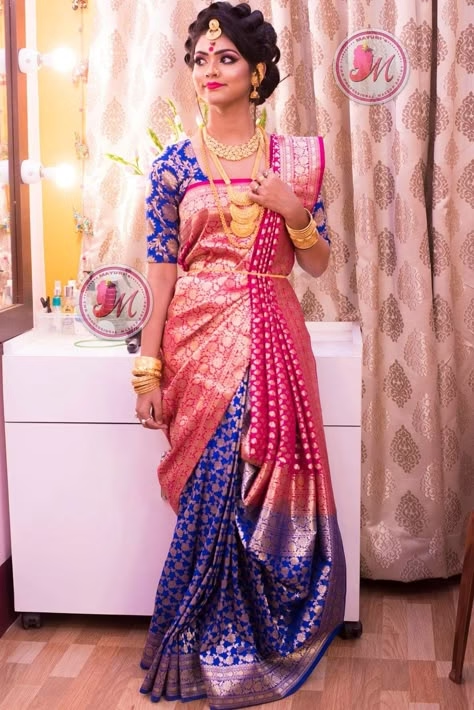
Among all wedding saree draping styles one must have come across ‘Coorgi style’ for its layered structure and rich cultural roots. This draping style, worn traditionally by Kodagu (Coorg) women in Karnataka, is for its back pleated pallu, the one-shouldered rear draping of pallu, the narrow waist, and the beauty is its simplicity.
Origin of the Coorgi Saree Draping Style
Coorg was a place of lush green hills, and the Coorgi saree draping style had its origin in Coorg, which was the home of the Kodava community. The Coorgi women had traditionally worn a actually, fashionable yet simple way of dressing, which gave freedom, yet the region’s pride is reflected in the dressing code. The style continues to be worn at weddings, religious events, and community festivals, thus maintaining its heritage.
How to Wear the Coorgi Wedding Saree Draping Styles
This unique wedding saree draping style is both functional and graceful, making it ideal for formal occasions and rituals. It typically involves a six-yard saree, though sometimes longer sarees are used for added pleating.
- Tuck at back: This time begin by tucking the plain end of the saree at the back (as compared to the usual front or side).
- Wrap Around the Waist: The shoulder and the waist are covered by wrapping the body backwards and forming pleats which open from the back part of the body, which is the crucial part of this saree.
- Pin the Pleats in: Place the pleats at the rear end back behind the waist and readjust the fabric, making it fit tightly.
- The Pallu to Go over the Right Shoulder: The Majority of the styles have the pallu passing the left side of the body, but in this style, it passes over the right shoulder and is fastened at the waist either with an ornamental pin or belt.
- Complete with Blouse or Jacket: In the traditional way, ladies used to complete the show with a full-sleeved blouse or a Coorgi-style tunic jacket.
When to Wear This Wedding Saree Draping Style
- Kodava Weddings – Necessary by emphasis on brides and the mature women who can attend the orthodox rituals.
- Courtships and Family Rituals- An excellent option in case you need to signify a local identity.
- Cultural Showcase or Theme Functions: A non-mainstream approach to the bridal drapes that are ideal to make a statement.
Why Choose Coorgi Style for Wedding Saree Draping Styles
- Classy & Unique: The pleating is inverted, and the silhouette is constructed very well and is unique compared to other wedding saree draping styles.
- High Culture Rating: A Syndicate that reflects the customs and aesthetics of the Kodava community.
- Relaxed and Realistic: It is very comfortable, but it enables you to move freely and yet have a formal and glossy appearance, which makes one seem very much at ease without making the delivery seem casual.
Styling Tips for the Coorgi Bridal Look
- The weight of silk sarees should be heavier and in strong maroons, green, or gold having bold borders.
- Combine with more traditional Kodava ornaments, such as layered necklaces, jewelled belts (dara), and gold bangles.
- Make your hair in a tight or loose bun or braid and pair it with fresh flowers or with a decorative comb.
- A long-sleeved blouse or tunic fixed in a classic Coorgi style gives a classic bridal look.
For brides looking to explore unique regional wedding saree draping styles, Coorgi style gives an excellent combination of local colours, grandeur, and originality to those who want to seek a special regional style of draping. Be it an Indian bride for Kodavas or a mere sheer fascination with the South Indian culture, this wrap will leave a fabulous impression.
Conclusion
The beauty of Indian weddings lies not just in rituals but in the diversity of attire, especially in the rich variety of wedding saree draping styles. The organized finesse of the Coorgi cover to the spiritual meaning of the Madisar, every style speaks of a culture and identity.
Exploring different wedding saree draping styles allows brides to celebrate tradition while showcasing personal elegance. Be it the Nauvari or the Nivi, both the styles of draping bring character to your bridal style-making even your wedding day significant and meaningful by sharing culture.
FAQs
What is the most popular wedding saree draping styles in India?
Nivi Style, the most widely used among all traditional Wedding Saree Draping Styles throughout India, originated from Andhra Pradesh. It is versatile, elegant, and compatible with most of the saree fabricwhich is why it is the choice of most of the brides and guests.
Which saree draping styles among all is best for South Indian weddings?
For South Indian weddings, saree draping styles like Madisar (Tamil Brahmin), Nauvari (Maharashtrian), and Coorgi style are popular as a choice. Those styles allude to their culture, these styles of the various local habits overall during the ceremony is and the wedding dress, to enrich the culture, a bridal wear.
Can I wear a six-yard saree for all wedding saree draping styles?
Whereas some of these wedding saree draping styles (such as Nivi, Bengali, etc.) can be performed using a six-yard saree, some wedding styles of saree wear (such as Nauvari, Madisar, etc.) can only be performed properly using a nine-yard saree.
Are modern brides choosing traditional wedding saree draping styles?
Yes! The majority of brides nowadays are picking up the classical traditional wedding saree draping styles as a way to respect the culture, and they have brought in the modern accessories, blouse work, styling flairs. These traditional drapes are gaining good ground in modern weddings.
